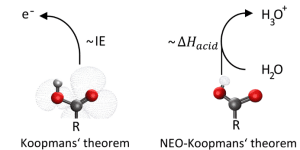Dr. Eva von Domaros
Image: PrivateDr. Eva VON DOMAROS
Email: eva.von.domaros@uni-jena.de
Phone: +49-3641-9-47705
Dr. von Domaros joined the Friedrich Schiller University of Jena in 2021 as an independent Junior Research group leader. With a background in both statistical thermodynamics and quantum chemical method development, her research is focused on the role of nuclei in electronic structure calculations with applications focused on materials and material interfaces.
Nuclear quantum effects in electronic structure calculations
Graphic Koopmans and NEO-Koopmans theorem
Image: Royal Society of ChemistryWithin the famous Born—Oppenheimer approximation, nuclear centers are routinely represented as classical point-charges and -masses. For certain applications, this is insufficient, for example when tunneling effects of hydrogen atoms are involved or if coupling between electronic and nuclear degrees of freedom is present. The latter one is often the case in photo-chemical processes, such as photo-catalysis or photoacidity. Therefore, so-called nuclear-electronic orbital (NEO) methods which explicitly incorporate nuclear quantum effects of (selected) atomic cores are developed in the von Domaros group. Just recently, this could be applied to predict deprotonation energies for a set of acid molecules from proton orbital energies with a great potential for the prediction of acidity in extended, periodic materials.
Machine-learning predicted anharmonicity
Vibrational effects significantly affect macroscopic material properties, including thermodynamic quantities in response to, e.g., optical stimuli. The harmonic approximation, which is routinely used to describe vibrational effects, is most often insufficient. The prediction of anharmonicity is, however, hindered by the complex dependence on several parameters, such as mode type, symmetry, or environment of the system. Therefore, we are currently building a database of explicitly anharmonically calculated vibrational data and apply machine learning techniques to predict anharmonic data for larger and more complex systems.
Material properties based on statistical approaches
Graph Material properties based on statistical approaches
Image: Eva von DomarosThe theoretical prediction of macroscopic material properties requires the description of extended systems so that usually, reliable electronic structure methods are infeasible and less accurate methods or approximations have to be applied. Using statistical thermodynamics, a cluster-based representation of the macroscopic material is achieved, which allows highly relevant electronic structure calculations on the cluster level to be transferred to properties of extended materials. For example, thermodynamic properties can be predicted, but also responses to optical excitation can be considered.
(Non-linear) optical properties of functionalized materials
The optical properties of 2D materials such as transition-metal dichalcogenides can be tailored by targeted design through functionalization. For a detailed understanding we conduct (TD-)DFT calculations to study the effect of functionalization (e.g. by adsorption of molecules or defects) on optical material properties. Therefore, we apply 2D-periodic electronic structure calculations as well as non-periodic calculations of finite clusters with and without functionalization.


